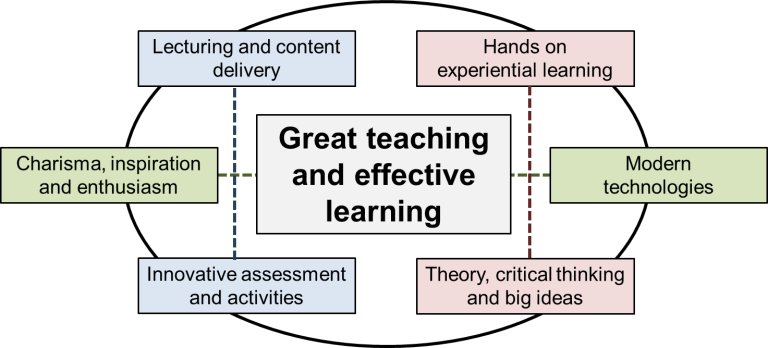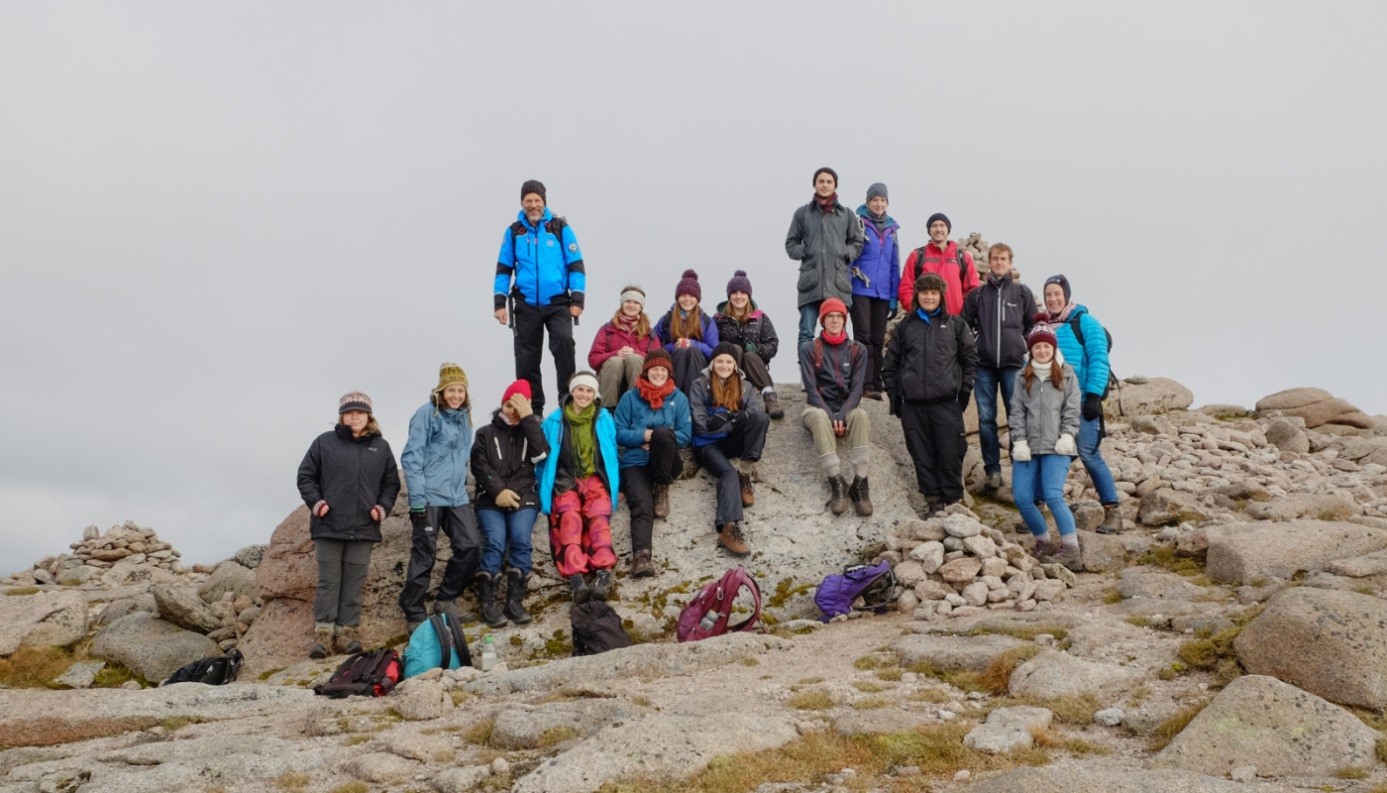
A student and a teacher from the Conservation Science course in the School of Geosciences share their thoughts on what makes good teaching.
Gergana Daskalova (student in the University of Edinburgh 2015 Conservation Science Course):
It is such a fantastic experience when you are not only taught, but also inspired – I want to become a teacher and that is the type of teaching I hope to one-day deliver to my students.
When I started my degree at the University of Edinburgh, I was eager to learn not only about ecology and environmental science, but also about teaching. During lectures, I took notes of methods I particularly enjoyed, and when I felt like teaching is not living up to its potential, I couldn’t help but wonder about how to improve it. As my graduation day quickly approaches, I often ponder upon my learning journey, and the different teaching approaches that contributed to it (see diagram).

There is no one style of good teaching – My experience as a learner and a volunteer secondary school teacher has taught me that the best teaching is the kind that can adapt to different learning environments and audiences. During my degree, BSc Ecological and Environmental Sciences, I found it especially motivating to see my lecturers in many different lights – from presenting in front of our class, to taking notes at seminars and sifting through soil in the field. Knowing that we are all learning helped me to connect with academia, and to develop a better relationship with my teachers.
Good teachers are captivating and can be innovative – For me, good teaching goes beyond just knowledge and pays particular attention to how knowledge is shared between teachers and students. I enjoy beautiful and well-structured presentation slides but I have also been utterly mesmerized by lecturers who seldom use PowerPoint or elaborate animations. Instead, they draw pictures with their words, enchant with the tone of their voice and leave room for imagination. Confidence and enthusiasm enhance both of those teaching approaches, and if executed rightly, both can stimulate effective learning.
Good teachers are not afraid to try new things – Although I acknowledge that there are “tried and true” methods, a teacher’s audience is not constant and as students change, so should teaching. I imagine this is a particularly challenging area for teachers, as with innovation comes risk, and student satisfaction does not necessarily increase after shifts in teaching paradigms. I can see how support from peers and academic institutions is instrumental for promoting teaching innovation, but here I want to emphasise the importance of feedback from students.
Education is not a one-way process – Great education happens when teachers and students work together. It is the teacher’s responsibility to ignite the initial spark for knowledge, but afterwards, both sides have to collaborate to keep the fire burning. Telling teachers what works well and identifying problematic areas is crucial for continuously improving the learning process. Only when there is an open discussion can both sides ensure their opinions are heard and acted upon.
Interactive teaching is often talked about – 59% of participants in the 2014 Teaching Practices Survey strongly feel that it promotes effective learning. Balancing activities with content delivery, however, remains a considerable challenge. In Conservation Science, we developed skills in critical thinking, science communication and conservation research through discussions, activities, innovative assessments and a field trip in the Cairngorms, all of which are documented on the course blog. Dr Isla Myers-Smith and Dr Aidan Keane openly shared their passion for science and expressed a great interest in improving our learning experience – we were often asked for feedback, and we felt like our opinion really did matter.
Conservation Science stands out among my degree courses because of the exciting science it taught me, but even more because of its fresh and engaging approach to teaching. Learning was not a one-way conversation, instead it was an exciting dialogue between teachers and students, and I felt very fortunate to participate in it. One day, I will teach my first university course and then I will think back to Conservation Science as a great example of the strong impact I want to have among students as a teacher.
——————————————
Isla Myers-Smith (course organiser of the University of Edinburgh 2015 Conservation Science Course):
Learning should be fun and engaging both for the student and the teacher – or at least that is my perspective – here are my thoughts on how to make that happen in response to Gergana’s perspective on good teaching:
Discussion and debate – One of my favourite things is to discuss and debate science and as such I am really glad that Gergana felt that the teaching in Conservation Science was a conversation. The students’ opinions really do matter to the debates we shared in Conservation Science, because these fourth year students are about to head out beyond the walls of the University to practice conservation and other fields in the real world. It is their opinion, not the opinion of us “Ivory Tower” scientists, that might have real influence on society and policy.
Challenging what we know and learning challenges – I hope to learn from my students just as they learn from me. I believe part of being a good teacher is being comfortable with not knowing everything and encouraging a class – teachers and students alike – to learn together. I also think being a good teacher is about sharing the challenges that you faced learning something in the past or the things you are currently trying to learn as a part of your research. Nothing is easy and really great teaching is about facing the challenges together as a team.
Controversial topics – In the Conservation Science course, we set out to expose the students to some of the hot topics in the discipline: How is biodiversity declining? How do we conserve species? How do we manage competing conservation priorities? All of these questions have no clear cut answers, and as such the perspective of each student, tutor and instructor in the course is equally valid. In the course, we asked the students to form their own opinion on a conservation hot topic and construct a reasoned scientific argument in the form of an opinion piece as an assessment.
Innovative assessment – Conservation Science was awarded the Innovative Assessment award at the EUSA Teaching Awards after nomination by Gergana and other students. Perhaps why the assessment was innovative was because we let the students choose their own topics and we designed assessments that replicated real-world activities in the careers of conservation scientists: the writing of opinion pieces, the coverage of conservation on social media, the presentation of findings in a conference setting and the development of PostNOTEs to communicate science to a public policy audience. Designing innovative assessment can be a challenge, but is a key part of improving the overall teaching experience. When students and teachers alike can engage with the assignments and the feedback process, it makes the course more fulfilling for everyone.
Mixing things up – One of the other important things for me in both teaching and learning is to use a variety of approaches. I have discovered that my attention span is pretty short, probably due to too much exposure to technology! I like to mix things up with lectures, discussions, data analyses, getting outside for a hands on activity, or learning a new technology – so I figure my students will like that too. I am very glad that Gergana appreciated the varied approaches that Aidan and I used with the course.
So in summary, I agree with Gergana that great teaching is all about a conversation between teachers and students, facing the challenging topics together, approaching the subject and assessment from a variety of angles, and engaging in the real world issues through thinking critically and forming opinions – opinions that could one day influence real world policy and change.





Fascinating insight for better teaching and creating a better learning educational environment.